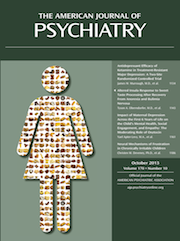Corrections
The authors of the article “Does Fetal Exposure to SSRIs or Maternal Depression Impact Infant Growth?” (Am J Psychiatry 2013, 170:Original article: 485-493) discovered two errors that did not substantially affect any of the results or conclusions: 1) Two cases were misclassified as being exposed to SSRI; therefore the number of women in the SSRI exposure group during pregnancy was reduced from 46 to 44. This affects some of the values in Tables 1 and 2 and the SSRI data in Figure 1. 2) When the data were passed into the packaged programs for calculating the percentiles according to the CDC, the percentiles for sex were switched (1=female in our data; in CDC program 1=male) in Figure 2. Revised Tables 1 and 2 and Figures 1 and 2 accompany this correction notice in the online edition.
The only results that change meaningfully (but do not affect the conclusions) and are not covered by the tables are presented here:
“The values observed in our study group were compared with the population statistics from the Centers for Disease Control and Prevention (www.cdc.gov/growthcharts/clinical_charts.htm) (Figure 2). The median length and weight measurements in all exposure groups were within the interquartile range (25th to 75th percentiles) of the general population of infants; therefore, the study group is reasonably similar to the general population. The median head circumferences were within the interquartile range for all exposure groups with two exceptions: infants with no exposure or exposure to MDD exceeded the 75 th percentile at 52 weeks of age.”
“No significant association between prenatal SSRI or depression exposure and growth in weight, length, or head circumference was observed. The unadjusted analysis revealed no association of prenatal exposure to weight (p=0.84), length (p=0.40), or head circumference (p=0.16). After we controlled for the characteristics that differed between exposure groups (race, education, employment, marital status, parity, presence of lifetime anxiety disorder, infant sex, and preterm birth) and included presence of depression at each postpartum time point, no significant association of exposure with weight (p=0.40), length (p=0.76), or head circumference (p=0.72) was observed. In addition, because maternal body weight affects aspects of infant growth, we evaluated the interaction of group and prepregnancy BMI, which was also nonsignificant, and no synergistic effect was identified for weight (p=0.79), length (p=0.81), or head circumference (p=0.97).”



